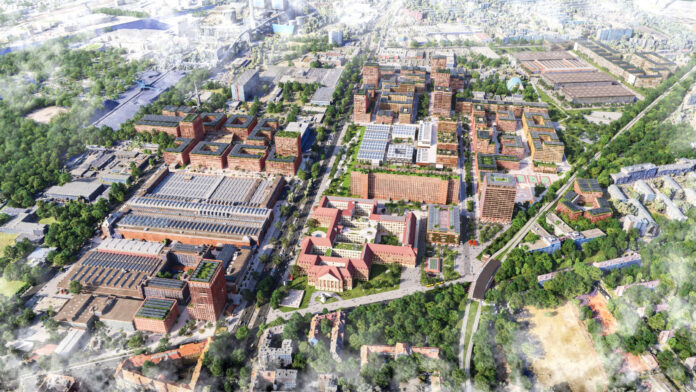Siemens has heralded a new €4.5 billion smart city regeneration project in Berlin as a “global blueprint” for urban brownfield development and industrial transformation. Siemens is to invest €750 million of its own money over the next decade to make Siemensstadt Square in the Spandau district of the German capital, originally settled at the end of the 20th century as a new industrial quarter by Siemens & Halske, a forebear of today’s Siemens, into a new model for the so-called fourth industrial revolution.
The new site will cover 270,000 square metres; the total floor space will top a million square meters. The plan is to create a business and residential district for around 35,000 people, with new homes for 7,000 people (30 percent of the space will be social housing) and new jobs for 20,000 people. The focus is on “digitalization of industrial production”. Siemens is to draw on technologies from its partners, as collected in its Xcelerator platform. The key to the proposition is a multi-sided digital twin that captures “all levels of the city”.
This includes the geographic “campus area”, its built infrastructure, plus its energy footprint. The live digital replica of the district will consolidate data points from a campus twin, a building twin, and an energy twin, said Siemens. “A complete virtual image of the district is created, and data silos are broken down. As a result, errors can be detected in the digital city and avoided in the real world. Potential for improvement can be continuously identified in the digital world and implemented, so that even visionary concepts can be tested and a livable future actively shaped.”
The various digital twins are already in use at Siemensstadt Square to redesign existing buildings, which have been occupied since the time of the second industrial revolution, when mass production swung into action. The campus twin, developed with Bentley Systems, is described as a “digital real-time master plan”, and is pulling live data on “everything from building information to planning status”. The building twin, part of Siemens’ own Building X software suite, is carrying out “photorealistic replanning of the existing area”.
Industrial buildings at the site have been integrated into a “walk-in” twin without interrupting their ongoing operation, said Siemens. The energy twin is being used, with data analysis and artificial intelligence (AI), to generate forecasts and monitor supply variants. Siemens is working with Berliner Wasserbetriebe, the city’s water utility, to install Europe’s largest wastewater heat exchanger (“of its type”). The district emits 3,000 tons of carbon dioxide per year; the new system will combine with heat pumps to supply the district with 100 percent carbon-neutral heating and cooling in 2026.
The €750 million Siemens has earmarked for the project is its largest-ever single investment in Berlin. The project was officially opened last week at a ceremony with the German chancellor, Olaf Scholz, and the mayor of Berlin, Kai Wegner. A showroom opens at the site this month; construction of new buildings starts from now (“construction phase for Module 1”). Scholz said: “Siemensstadt will remain what it has been for 125 years – a place of new beginnings, a place of the future and of confidence.”
Kai Wegner, Governing Mayor of Berlin, said: “We are marking the start of an exciting urban development project: an advanced, sustainable smart city in the middle of one of Berlin’s fastest-growing areas for new construction. It will significantly help Germany’s capital city to reach its climate targets and attract skilled workers, in part because the neighbourhood will offer housing with a high quality of life.”
Roland Busch, president and chief executive at Siemens, said: “Siemensstadt Square will be the blueprint for the city of the future. The project will combine artificial intelligence, digital twins and other technologies from the Siemens Xcelerator platform to transform an industrial brownfield area into an engine for solid, healthy growth. Net zero will be ensured through automated production and building technology, optimised energy management and green mobility. It will be a blueprint for sustainable growth and competitiveness through digitalization.”

